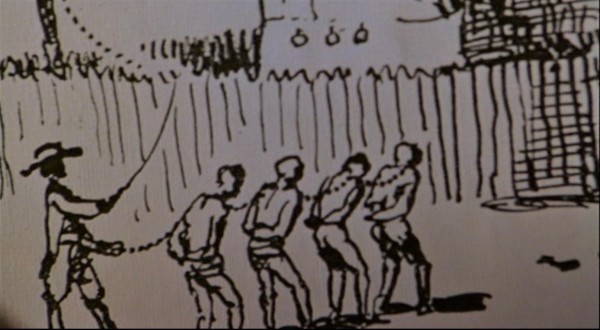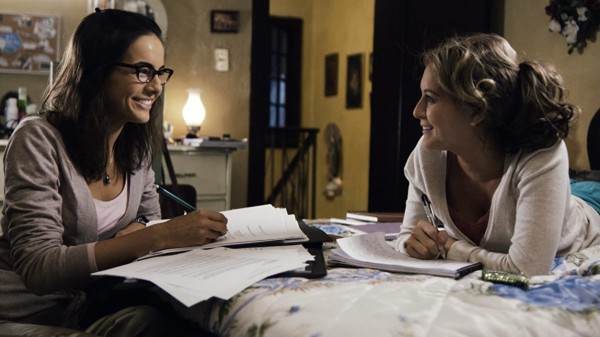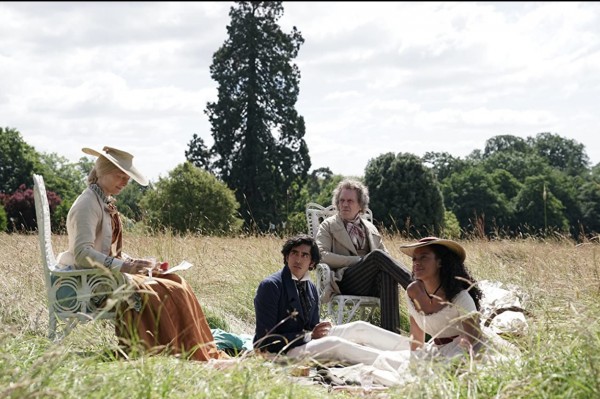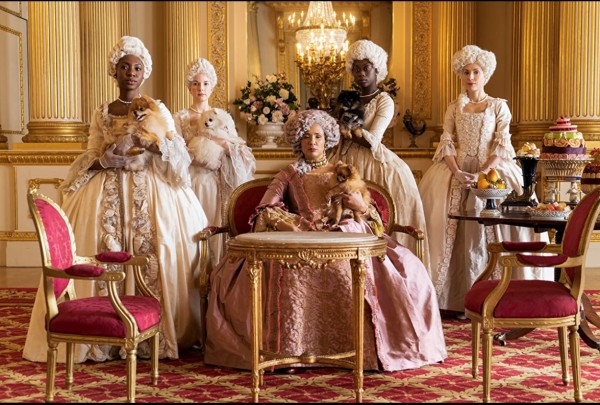The popularity of the Netflix series Bridgerton has highlighted an issue that has been simmering in discussions in the Jane Austen fandom: that of racial representation in screen adaptation. Bridgerton is not, of course, a Jane Austen adaptation, but in the popular mindset, the Regency romance has been identified with Austen, and Bridgerton was hyped as “Austen meets Gossip girl” (Maas). The fact that the series has a Black romantic lead (race is not mentioned in the novels on which it is based) highlights the absence of similar representation in actual Austen properties.
As an Austen fan and a theatre-maker and a person of color myself, this attention to representation raises questions I have asked myself as well. Is it enough to be color-conscious in casting, when putting out a call for “all ethnicities” is likely to result in a majority-white pool of applicants? What does it look like to adapt a classic of the Western canon with race in mind? What does “equality” mean with regard to race in Austen and in adaptations of Austen? In this essay I will explore some of the approaches taken with regard to race when adapting Austen for the screen and consider how other historical films or series can indicate some of the possibilities for adapting Austen.
![]()
If adaptation of a text is on a spectrum with translation or paraphrase, as Linda Hutcheon argues (16), then it can also be argued that at the other end of the spectrum is the writing of fan fiction, in which varying degrees of freedom are assumed in approaching the original text. The scope of texts that can be considered “based on” or “riffs on” Austen is wide, and there is increasing recognition that the aim of any adaption is not simply some remote ideal of “faithfulness” (Hutcheon 7). Even the most faithful adaptations require interpretation: is Darcy rude or absentminded? is Elizabeth forthright or angry? and so on, at each turn. The 1995 BBC adaption of Pride and Prejudice, widely considered to be laboriously faithful to Austen’s text, opens with a scene of purely invented dialogue between Darcy and Bingley—though Austen never wrote a scene between two men that did not include a lady present as well. Thinking about adaptation on the same continuum as fan fiction is useful because it distances the adaptation from the (false) pressure of being faithful to the text, it encourages creativity in the process of adaptation, and it allows for thinking about adaptations in similar ways to thinking about fan fiction. Sheenagh Pugh discusses fan fiction in terms of pieces that want “more of” the same things that authors saw in the original versus those that want “more from” what was initially present.
Jane Austen is, fairly or unfairly, part of the “white” literary canon (Gonsalez). She herself was a white woman, and she wrote about mostly white women, for mostly white people. That was two hundred years ago. Now, there are Jane Austen appreciation societies in countries where English is not a majority language, which include people of color, people whose ancestry is far removed from the English landed gentry of the early nineteenth century. In fact, her fans include those whose cultural heritage suffered at the hands of the colonizing soldiers such as Sense and Sensibility’s Colonel Brandon or the plantation-owning Sir Thomas Bertram of Mansfield Park. These readers are not encouraged in their identification with Austen by the texts themselves, in which no people of color speak, nor even by literary academic institutions, which can be dominated by whiteness (Gonsalez). As I have argued elsewhere (Chua), Austen is part of a literary tradition and literary canon that were used as part of the imperialist colonizing process. It is not just that Austen depicts a lifestyle based on deep colonialist, racist, classist, and sexist roots. Austen has been used through history to try and spread the values of the colonizer among the colonized (García-Periago).
In the context of current theories about intertextuality, adaptations are not only influenced by the original text, but they speak to that original text and can influence how we read it. The value of screen interpretations involving people of color is therefore not just in the film or television show produced. Such an adaptation has the capacity to alter and influence how Austen’s texts themselves are read and how Austen is perceived.
Austen is a ripe subject for screen adaptions. Television miniseries and films adapting her work show no signs of diminishing in popularity (Sadoff). It is worth considering specifically film and television separately from the stage (although Austen adaptions are popular there too), since screen media are considered to be very literal and naturalistic (Hutcheon 46) in comparison to the stage, where color blind or color conscious casting is common in productions of classic Western texts.1
One option in adapting Austen is to continue to cast white or white-presenting actors in most of, if not all, the roles. The recent Emma film adaption directed by Autumn de Wilde was notable for its lack of evident diversity in casting. For all its filmic innovation and stylistic flourishes, this film bypassed any discussion of race in its interpretation of the text. De Wilde’s Emma represents Sheenah Pugh’s “more of” approach to Austen fan fiction: catering to an audience that wants more of the things that they have previously seen in Austen’s novels and in previous adaptations. It is certainly a valid approach, and in the context of majority-white creatives may be one strategy to avoid appropriating the experiences of people of color. But it might be time to make space for new kinds of adaptations. Adaptations reflect not only the original text but the time and place of their own creation, even if the setting has not changed (Hutcheon 142). Thus, in the social and cultural context of discussions about race and colonialism, it is only appropriate that our adaptations of Austen reflect that awareness and those conversations.
Alternative approaches take on varying degrees of Pugh’s “more from” when interpreters are not content to exclude people of color from their screens. Similar approaches to adaptation may be taken, for example, with the inclusion of LGBT readings.
There have been adaptations that choose to highlight some of the issues that Austen alludes to only obliquely, if at all. The film adaptation of Mansfield Park written and directed by Patricia Rozema in 1999 shows us the brutal treatment of slaves on the Bertram plantation in the West Indies. This approach picks up on the hints that Austen drops and expands them in retellings, making clear some of the novel’s subtext as well as how the imperial context, the Bertrams’ estate in the West Indies, impacted on people of color. This approach keeps people of color in roles defined predominantly by their race—where their main concerns within the story are to do with race, and particularly the suffering they endured because of slavery and racism. People of color participate, but as victims rather than as heroes or heroines.

From Tom Bertram's Antigua sketchbook. Mansfield Park © 1999 Miramax Films.
The mini-series Sanditon also went some way to addressing issues of global racism and the slave trade. Austen’s “West Indian heiress,” who in her unfinished book was silent, “roars” (Matthew) in Andrew Davies’s series, having been given lines, a storyline, a love story, a personality, and a capacity to push back against racism. For all the progress of this move, Crystal Clarke, the actress who portrayed Georgiana Lambe, has in interviews referred to the isolating nature of often being the only Black actor on set, with all the attendant possibilities for misunderstandings (“Sanditon Cast”). In a now-deleted tweet, she has previously said that she would only return for a second season if there were people of color working as writers on the show—something that did not happen in the show’s first season (@HereForSanditon).
Sanditon the series provoked heated discussion about race among fans, especially regarding the pineapple as a symbol of support for the show (Chua). The pineapple was, in the series as well in history, a product and a symbol of the brutal colonization of the West Indies and the racism experienced by people of color in that context. In other words, it was a symbol of the oppression itself rather than of having overcome the oppressor. The use of the pineapple emoji by fans to indicate support for the show and the variety of reactions to being asked by people of color to find another symbol indicate the deep divides between fans when it comes to approaching the issue of race within Austen and other historical dramas as interpreted for screen.
The intense discussion and sometimes animosity between fans of the show over the issue of race, as well as the experiences of the actor playing Austen’s only specifically Black character, make it clear that the fandom still has a long way to go in terms of prioritizing the voices of people of color when it comes to issues of race and even in terms of basic understanding of the racial makeup of England during the Regency. The mere existence of Black or Asian people in period dramas is still met with incredulity and hostility.
An option for inclusion of people of color, which does not generally arouse the same ire that people of color in a historical drama do, is the modern reinterpretation. We have seen Austen set in America as well as in the south Asian subcontinent and its diaspora. Adaptions include Bride and Prejudice (Chadha), which transforms Pride and Prejudice to a global story, based in India and the Indian diaspora, and From Prada to Nada (Gracia), in which Sense and Sensibility is updated to take place among the Latinx community of Los Angeles.

Nora Dominguez (Camilla Belle) and Mary Dominguez (Alexa Vega). From Prada to Nada © 2011 Pantelion Films.
Bride and Prejudice draws parallels between arranged marriages and the pressure on the Bennet sisters to marry and draws its class divides on a global scale, celebrating Indian culture and critiquing cultural imperialism and neoliberalism. But a closer reading opens the film up to the question of whether the “India” that is offered to Darcy in the film (and, by extension, to viewers) has been commodified and exoticized to appeal to Western commercial sensibilities. The accusation thrown at the proud Darcy may well be one that applies to the film itself (Wagner 110). (In this version, Wickham appeals to Lalita/Lizzy partly through his expressed desire to experience the “authentic” India—a move that surely ought to render depictions of “authenticity” suspect.)
The process of “translating” Austen into contemporary cultures runs the risk of exoticizing and simplifying complex current social interactions. These ongoing attempts, however, are not only entertaining but valuable in the ongoing discourse around Austen and whiteness. There are superficial parallels to be drawn between aspects of non-Anglo communities and Regency English society (Sukhera)—the emphasis on marriage, the role of women, family involvement in choosing marriage partners—but these examples without nuance can lean into stereotypes of non-Anglo “other” cultures and risk reducing both Austen’s work and people of color to caricature.
These adaptations to contemporary cultures don’t actually challenge the whiteness of Austen, or the whiteness of readings of Austen, as they are clearly understood to be retellings or adaptations in ways that remove them from the original Austen text. We expect that transcultural adaption will necessitate change (Hutcheon 145). In one sense these adaptations are let off the hook of having to produce “faithful” adaptations of Austen’s text—but that does mean that any insights in the film might not be connected back to Austen’s texts.
![]()
These have so far been the approaches taken to screen adaptations of Austen. But to address the key problem—that of acknowledging the role of colonialism and race in Austen’s novels as well as the role those novels have played in the colonizing process—more is needed. The following approaches have not yet been taken with respect to Austen on film but can inform how we see race representation in Austen retellings.
One possibility is color-blind casting in a Regency setting, without acknowledging or referring to race—in the model, for example, of The Personal History of David Copperfield, starring Dev Patel (Iannucci). There is something poignant about the cast-off orphan being a person of color in London at that time, but it is not referred to, nor is it explained, since his mother is white, and his father’s sister is white. This approach allows for the casting of people of varied ethnicities, even in a family drama. It allows for people of color to be in lead roles, including lead romantic roles. It allows audience members of color an opportunity to see themselves as the heroes in the colonial literature that has been revered as classic, without being relegated again to perpetual victimhood or the margins of the story. It underlines the multicultural and multiracial society of the time, which is “whitewashed” in many other productions.

Betsey Trotwood (Tilda Swinton), David (Dev Patel), Mr. Dick (Hugh Laurie), and Agnes Wickfield (Rosalind Eleazar). The Personal History of David Copperfield © 2020 Lionsgate.
This approach corrects some of the historical imbalance but doesn’t deal in a substantial way with race. David Copperfield is not a piece that has a great deal to say about race or racism, either at the time or in our current time, and the film runs the risk of tokenizing race representation without depth (Warner). Perhaps racial commentary is not always necessary, but there is no doubt much that could be said about race with respect to Dickens. An equivalent for an Austen novel (that we have not yet seen) would be casting people of color as Austen’s heroines, without regard for whether it “makes sense” in terms of their physical descriptions or even the family relationships within the book.2
The television series Bridgerton takes a different approach to the depiction of race in the Regency era. Regency representation almost always conjures Austen in the popular consciousness. Many pop culture discussions have drawn lines from Austen to Georgette Heyer to Julia Quinn, who wrote the novels on which the series is based (Bagchi). The key elements are the Regency setting and the purportedly happy romantic pairings. Bridgerton makes some gestures in the direction of social commentary, but it is primarily an adaptation of historical romance.
Bridgerton has garnered a lot of attention for casting people of color in high-ranking roles, including the queen and a duke. Race is mentioned, and the presence of people of color in the aristocracy is accounted for within the show, but, as Patricia Matthew points out, it is not without discomfort, especially when the full implications of people of color being placed into positions of power in Regency England are not explored. The Netflix series posits a historical reason for the inclusion of Black members of the aristocracy, and this brief explanation has been divisive among viewers. If Bridgerton is seen as fantasy (in the same way that Austen is often seen as fantasy), then it doesn’t matter if the presence of Black people in the aristocracy is explained; but if it is to be grounded in reality, then race ought to be play a larger role in social interactions even (perhaps especially) if Black families had been recently granted additional privileges by the monarch (Romano).

Queen Charlotte and her ladies in waiting. Bridgerton © 2020 Netflix.
Perhaps this last distinction is the most important one with regard to how future adaptations of Austen might think about the inclusion of people of color. Do we see Austen as fantasy? Is Austen primarily a purveyor of frothy escapist fiction? If so, then in Regency as fantasy there is no reason why actors of color cannot play any role (as in the David Copperfield adaptation). However, if we are to take Austen’s works seriously—not in the sense of being devoid of humor, but in the sense of having nuanced and relevant things to say about society and people—then casting of people of color in adaptations of Austen novels is an opportunity to explore race within both a Regency context and for our contemporary situation.
What if, for example, Captain Wentworth were a person of color? That would certainly change the way we assess Lady Russell’s persuasive argument that he would not be a good match for Anne. It would add layers to our understanding of Wentworth’s own character, as his naval career would undoubtedly have included some contact with various aspects of British slavery and imperialism.
What if, to take another example, Fanny Price were biracial? That would be an added dimension to the treatment she suffers in her uncle’s household, and maybe even to her desire to discuss slavery with her uncle.
The above examples are not outside of the possibilities of “canon” with respect to Austen, insofar as we are not explicitly told that these characters are white.
It is sadly still controversial to note that a less “white” approach to screen adaptations of Austen would be welcome; that is the first hurdle to be overcome in devising and creating more adaptations with differing approaches to race. But as more people of color identify as Janeites and want to grapple with the colonial history of Austen’s work in their loving adaptations of it, we will continue to see new approaches to screen adaptation and race, and Austen will continue to inspire global conversations. As Leslie Odom, Jr., who played Aaron Burr in Hamilton, has said of race representation: “What matters next is the next two seasons” (Warner). We can learn from the past as we look to a more diverse and inclusive future.
NOTES
1Shakespeare adaptations, for example, have been cast with people of color in traditionally white roles for some time. The same is happening with other stage adaptations of the literary canon, including Austen adaptations.
2It is worth noting that issues of “authenticity” that arise around race in film are always very selective when it comes to, for example, the authenticity of dental hygiene or women’s shaved bodies in historical context.
